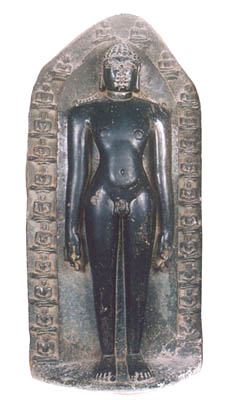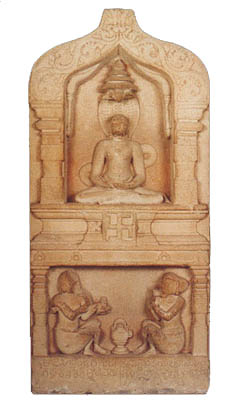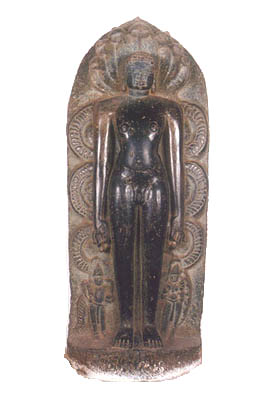 |

|
Chaturvimsati
with Adinatha
Height 86 cm., Breadth 40 cm.
Probably from Mysore Region, Karnataka.
Circa 11th Century AD
This beautiful relief sculpture depicts a prominent central figure of
a Tirthankara surrounded by twenty-four Tirthankaras of smaller size. Such a
type of representation is called as Chaturvimsati (meaning 24 in Sanskrit). Usually
the the number of the surrounding Tirthankaras should be the remaining 23, but in
this sculpture they are twenty-four and makes the total number including the prominent central
one, twenty-five. The Mula Nayaka or the prominent central Tirthankara is in
the Kayotsarga (standing erect) pose. All the surrounding smaller Tirthankaras
are in the seated Dhyana-Padmasama pose. The Mula Nayaka's broad
square face with curly hair tempts us to compare this sculpture with the countenance of the
colossal and famous statue of Bahubali, the second son of the first Tirthankara
Adinatha at Sravanabelagola, Mysore region. The hair locks that fall on
either shoulder of the standing Tirthankara helps us to identify him as Adinatha
or Rishaba Deva.
|
Adinishidhi
Pillar
Height 97.5 cm., Breadth 46 cm.
Danavulappadu, Cuddappah District, Andhra Pradesh.
Cirea 14th Century AD.
This Nishidhi pillar
has two panels. The upper panel is designed in the form of an arched Mandapa
(pavilion) with a Simha mukha ((lion face) at the top. The arch has floral designs
carved on it and is supported by two pillars. These pillars are like temple pillars with parts
like Kalasa (pot like structure) and Chaturams (square like structures). The
Tirthankara is shown seated in a meditative (Dhyana - Padmasana) lotus pose.
At his back is a single headed cobra. This is one of the identificaton marks of Suparsvanatha.
One coil of the cobra behind the left shoulder and another coil behind the right elbow are
depicted. It spreads its hood over the head of the Tirthankara serving the purpose of
a canopy. Mukkudai (triple umbrella ) and a pair of Chamara (fly-whisks) are
also depicted.
The Swastika symbol in the median band, which divides the
upper and lower panel, is one of the identification symbols of the seventh Tirthankara,
Suparsvanatha.
In the lower panel designed as a rectangular Mandapa, two
worshippers are depicted. This Mandapa is supported by two pillars like the upper
portion. These figures are described as male and female. But actually both are males. The
inscription on the epitaph found below the lower panel confirms that both are males. Between
them is a Gindi (a vase). under the lower panel are two inscriptions divided by a
vertical central line. The first part runs thus - "Kanakakirti Deva, the
Preceptor of Adi Chetty.... " and the second - " The Nishidhi
(epitaph) of Adi Chetty, son of Ballavva Singi Chetty of
Penukonda". According to this epigraphical evidence, both the figures are males and
they are teacher and pupil. |

|

|
Parsvanatha
Height 108 cm., Breadth 46 cm.
Probably From Mysore Region, Karnataka.
Circa 11th Century AD.
Parsavanatha, the 23rd Tirthankara is in a standing
pose. His two attendants are depicted as being dwarfed by him. Three coils of the snake are
shown on each side of his body from the knee to the shoulder carved on the backdrop. The
attendant at the right side carries a Chamara (fly-whisk) in his left hand. He may be
the Yaksha Dharanendra. The attendant on the left side seems to carry a
fruit or sweet meat in her right palm. She may be his Yakshi Padmavati. Parsvanatha's
symbol, the seven headed snake spreads its hood over the head of Parsvanatha. It acts
as a canopy. The style of carving the sculpture especially the fingers with fine curves and
nails, the slim and stout body and the broad square countenance are similar to those of the Chaturvimsati
Adinatha sculpture descriped above. Both sculptures belong to the same Rashtrakuta
Art School, Place and period. |
|

|
|